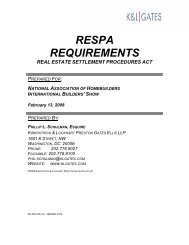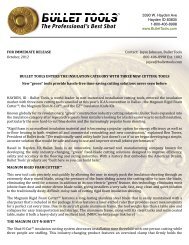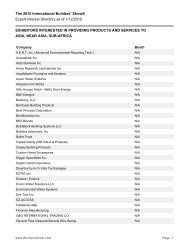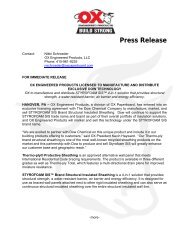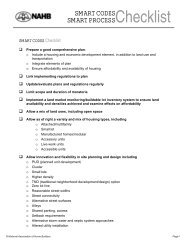Minimize Risk â Maximize Profits From Land Acquisition to Final ...
Minimize Risk â Maximize Profits From Land Acquisition to Final ...
Minimize Risk â Maximize Profits From Land Acquisition to Final ...
You also want an ePaper? Increase the reach of your titles
YUMPU automatically turns print PDFs into web optimized ePapers that Google loves.
International Builders ConferenceOrlando, FLJanuary 2006<strong>Minimize</strong> <strong>Risk</strong> – <strong>Maximize</strong> <strong>Profits</strong><strong>From</strong> <strong>Land</strong> <strong>Acquisition</strong> <strong>to</strong> <strong>Final</strong> Home ClosingBonnie Alfriend, MIRMCharles Graham, MIRMDaniel Levitan, MIRM<strong>Minimize</strong> <strong>Risk</strong>s <strong>Maximize</strong> <strong>Profits</strong> <strong>From</strong> <strong>Land</strong><strong>Acquisition</strong> <strong>to</strong> <strong>Final</strong> Move-In1
Bonnie C. Alfriend, MIRMbalfriend@aol.comBonnie Alfriend is President of Alfriend Sales & Marketing Solutions, a consulting and trainingfirm, serving builders, developers, and sales and marketing executives. As a former homebuilderBonnie is known for her unique ability <strong>to</strong> reduce overhead while maximizing profits through effectivesales and marketing strategies. She is best selling author of Secrets of The Superstars and New HomeSales Management. Bonnie is the recipient of NAHB/NSMC Trina Ripley, Excellence In EducationAward. She is a frequent speaker at National & International Builder Conferences as well as aprinciple instruc<strong>to</strong>r for all IRM courses. She is past president of The Institute of ResidentialMarketing. She is a lead author on ‘Effective Marketing on a Shoestring Budget’ (EMSB) and‘Certified New Homes Sales Professional’ (CSP) for NAHB.Charles G. Graham, AIA, LAI, MIRMCgraham6@bellsouth.netAs the principal of New<strong>to</strong>n Graham Consultants, Chuck directs all feasibility and marketingassignments as well as general management consulting in the areas of strategy development,organizational structuring, control systems and financial management. He is past Chairman of theNAHB National Sales and Marketing Council, and past President of The Institute Of ResidentialMarketing. Chuck is the principal author and a national instruc<strong>to</strong>r for the Institute’s required courseMarketing Strategies Budgets and Plans. He is the recipient of the National Association of HomeBuilders ‘Trina Ripley Excellence in Education Award’ and co-author of “<strong>From</strong> Plan <strong>to</strong> Profit,published by the Home Builder Press of NAHB.Daniel Levitan, MIRMdlevitan@bellsouth.netDaniel Levitan is President of Levitan & Associates, a Florida-based strategic consulting firmserving builders, developers and lenders nationwide. He is acknowledged as one of the country’spreeminent strategists for residential development providing feasibility analysis, valuationdetermination, community positioning and optimization studies, marketing strategies and 0ongoingimplementation assistance for properties throughout the United States, Canada and the Caribbean.Levitan has numerous professional designations and has served as multi-term trustee and Presiden<strong>to</strong>f the Institute of Residential Marketing, Dan has been recognized for excellence by his peers asrecipient of Florida Home Builder’s “John P. Hall Award”. The Institute of Residential Marketing’s“Excellence In Education Award” and the National Association of Home Builder’s “Bill MolsterAward”.<strong>Minimize</strong> <strong>Risk</strong>s <strong>Maximize</strong> <strong>Profits</strong> <strong>From</strong> <strong>Land</strong><strong>Acquisition</strong> <strong>to</strong> <strong>Final</strong> Move-In2
<strong>Minimize</strong> <strong>Risk</strong> – <strong>Maximize</strong> <strong>Profits</strong><strong>From</strong> <strong>Land</strong> <strong>Acquisition</strong> <strong>to</strong> <strong>Final</strong> Home Closing“The Greatest thing in the world is not so much where we are, but inwhat direction we are moving.” – Oliver Wendell HolmesIn order <strong>to</strong> balance risk and reward one needs <strong>to</strong> be keenly award of market conditionsand change while being cautiously aggressive <strong>to</strong> adjust ones business plan <strong>to</strong>accommodate those changes. Be careful <strong>to</strong> balance your vision with value. Volume inand of itself does not necessarily generate more profits.Let’s take a look at several areas that can and will put you on the cutting edge <strong>to</strong><strong>Minimize</strong> <strong>Risk</strong> and <strong>Maximize</strong> Profitable Revenue in 2006 and beyond.I. The Market: Challenges and OpportunitiesII.The Competition: Out think them don’t out spend themIII. The Cus<strong>to</strong>mer: Attitudes and Lifestyle ChangesIV. The Company: Strategic Plan of Attack4 P’s of Marketing – Product, Price, Place and Promotion<strong>Minimize</strong> <strong>Risk</strong>s <strong>Maximize</strong> <strong>Profits</strong> <strong>From</strong> <strong>Land</strong><strong>Acquisition</strong> <strong>to</strong> <strong>Final</strong> Move-In3
I. The Market: Market Conditions and Future Outlook:What’s really going on in the housing market? Is the residential real estate marketgrowing or shrinking, are consumers confident or miserable, is the home buildingindustry full of fluff or substance, are we positioned for feast or famine? How does onetruly know the Big Picture? With the increase interest in housing and real estateinvestment, unfortunately it is harder <strong>to</strong> distinguish reliable, accurate informationfrom just hype.In the next few years many housing markets in the U. S. will level off if for no otherreason the supply of new homes out number the demand for new homes. The time forserious business planning is NOW. Most economists agree that depending on marketdriven success for the future will be a big mistakeOne can never know <strong>to</strong>o much about the marketplace, housing cycles, job formations,and future opportunities. The key <strong>to</strong> understanding The Market is knowing yourCus<strong>to</strong>mer, your Competition and your Company.To assist homebuilders in getting it right NAHB continues <strong>to</strong> provide a multitude ofservices and resources for the Housing Industry. According <strong>to</strong> Jerry Howard, NAHBexecutive vice president and chief executive officer, “we created Housing Facts, Figuresand Trends <strong>to</strong> provide a convenient and accurate resource for members, the media,inves<strong>to</strong>rs and others.” To access the online site go <strong>to</strong> www.nahb.org/fft. Some of themajor sections include:Latest NAHB reportsHousing EconomicsSenior HousingMultifamily HousingNAHB Facts and Pho<strong>to</strong>sGreen BuildingTips To Keep Your Eye on The Market and You In The Game:♦ Resale Homes: Moni<strong>to</strong>r housing trends in the resale market: Days on market – askingprice compared <strong>to</strong> selling price. Your greatest competi<strong>to</strong>r is not the builder down the road.Resale homes out sell new homes in every market. The resale market determines housingpricing. Consumers will pay more for a new home. However, there is a limit <strong>to</strong> how much<strong>Minimize</strong> <strong>Risk</strong>s <strong>Maximize</strong> <strong>Profits</strong> <strong>From</strong> <strong>Land</strong><strong>Acquisition</strong> <strong>to</strong> <strong>Final</strong> Move-In4
more they will pay; generally around 15%. Housing trends in resale homes precede new hometrends by around 120 days. The pace of absorption in resale homes is good barometer for howbusiness is evolving. In many markets there is an excess of homes for resale – your firstindication for a slowing market.♦ Housing Cycle: Each market differs in the intensity of each stage in the cycle. In a downcycle watch your supply. A good rule of thumb – keep your housing offerings no more than 90days of absorption. For example if you are selling 8 homes per month you should have nomore than 24 opportunities or choices for potential buyers. Otherwise you are competing withyourself. Grand openings last week in December may not be your wisest choice.♦ Job Growth: Growth in household formations is driven primarily by increase in new jobs.Know both the quantity and the quality of jobs entering your submarket. Keep in mind thechanging demographics in the job market including work from home opportunities andtelecommuting. When jobs start <strong>to</strong> shrink immediately go <strong>to</strong> contingency Plan B.♦ Economic Fac<strong>to</strong>rs: Certainly rising interest rates is of concern. Rates impact first timehome buyers as well as move up buyers’ dependant upon selling their home <strong>to</strong> buy up.Multifamily neighborhoods that have been on the increase in recent years will feel thepressure <strong>to</strong> change their focus <strong>to</strong> a different target market, such as active adult market whereinterest rates are not as much a concern. Work with your preferred lenders for creativemortgage plans. Consider buyer assistant financial incentives rather than product incentives.II.The COMPETITION: Tips To Out Smart Not Out Spend ThemAccording <strong>to</strong> NAHB Economist David Seiders the housing market is poised <strong>to</strong> recede frompeak levels. It appears that absorption levels are beginning <strong>to</strong> plateau albeit at a healthy pace in manymarkets. What does this mean for homebuilders? Quite simply; market share will be lost thus drivinga fierce need for gaining a better competitive advantage. Fierce competition continues <strong>to</strong> demand<strong>Minimize</strong> <strong>Risk</strong>s <strong>Maximize</strong> <strong>Profits</strong> <strong>From</strong> <strong>Land</strong><strong>Acquisition</strong> <strong>to</strong> <strong>Final</strong> Move-In5
Product Opportunities: Another effective way <strong>to</strong> minimize risk and maximize return on yourinvestment is <strong>to</strong> build <strong>to</strong> your cus<strong>to</strong>mer’s desires and needs.Keys <strong>to</strong> Revenue Producing Product StrategiesActive Adult Market: Consider changing product design <strong>to</strong> meet needs of Active Adults.Exterior: Do not neglect your Exteriors. Buyers make a decision <strong>to</strong> get out of their car based on theexterior appearance. The most cost effective visual amenity <strong>to</strong> your neighborhood is a world classlandscape design. Try taking a couple of dollars from the inside <strong>to</strong> add drama <strong>to</strong> the outside of yourhomes.Interior: Flex rooms are in. Changing demographics and household formations have increased theneed for alternative uses of space. You will attract a larger segment of the market with more flexiblefootprints and alterative plans for room allocations.Denser product: Urban growth and city living brings new opportunities for homebuilders as thesuburbs become satiated with product. More challenging sites and innovated designs incondominiums, <strong>to</strong>wn home, lofts, and villas, as well as single family homes on smaller lots bring moreredevelopment opportunities involving environmental cleanup.• Include features that matter most <strong>to</strong> your target market.• Option up inclusions that are not as important <strong>to</strong> your cus<strong>to</strong>mers• The #1 Measure of quality in mind of consumers is Kitchen Cabinets.Upgrading cabinets in model can increase perceived value for your visi<strong>to</strong>rs.• ‘Wood Is Good’ – use it as often as you can.• Natural Materials or ‘look a likes’ are favorite choices.• Go ‘Luxury’ in every price point.• Integrate the latest features from your manufactures.Control Material Waste:Eliminate Waste and Excess Material UsageDevelop scope of work for subcontrac<strong>to</strong>rsPolice diverted materialsWatch for excess materials installedReturn extra materials for credit immediatelyValue Engineer PlansImplement material and labor saving techniquesGain control of Construction Slippage<strong>Minimize</strong> <strong>Risk</strong>s <strong>Maximize</strong> <strong>Profits</strong> <strong>From</strong> <strong>Land</strong><strong>Acquisition</strong> <strong>to</strong> <strong>Final</strong> Move-In10
Partner with other small builders <strong>to</strong> control your subs and keep them loyal <strong>to</strong> your needs.Place or LocationThis is a great time <strong>to</strong> explore niche products or needs in your market that have not been met. Smallbuilders have an added advantage of changing more quickly with market shifts.Urban Opportunities: People want <strong>to</strong> be close <strong>to</strong> the things they love; work, social, recreation, etc.Rising costs of gasoline, growing singles market, and more demands on ones time are driving manyback <strong>to</strong> city living. Unfortunately, in many areas the average family cannot afford the single-familyhome on a large lot with a big backyard. Many are making trade-offs. Note: In major metro areas inU.S. married couples with children not longer dominate the suburbs.Tips for Winning Places:Select a Site That Captures Your Attributes and Your ProductBuild across from the ‘Big Boys’Value Index each lot <strong>to</strong> maximize the price for sun orientation, uniqueness, vistas,views, & sizeDo not market the best sites within your location firstRegularly create excitement and freshness from the outside.Create Sizzling Budget Sensitive <strong>Land</strong>scape Design<strong>Maximize</strong> the appeal of your land plan, streetscape.Make sure your entry creates excitement.Keep sites clear and free of trashClearly mark all lots – site homesKeep signs clean and visibleBuilders with the growth potential <strong>to</strong> diversify in<strong>to</strong> multiple markets should seek markets with stronggrowth and appreciation potential with limited risk. In 2006 it is imperative for builders whodiversify in multiple markets <strong>to</strong> direct more monies in<strong>to</strong> markets where job growth is strong anddemand continues high and supply low.<strong>Minimize</strong> <strong>Risk</strong>s <strong>Maximize</strong> <strong>Profits</strong> <strong>From</strong> <strong>Land</strong><strong>Acquisition</strong> <strong>to</strong> <strong>Final</strong> Move-In11
Price: Develop a pricing strategy that represents value for the consumer. In a free-market economy,cost doesn’t determine price. Prices are established by market forces-such as the competition and howmuch consumers are willing <strong>to</strong> pay. Your costs cannot be passed on <strong>to</strong> consumers in the form ofhigher prices unless there is apparent value <strong>to</strong> your cus<strong>to</strong>mer in those increases.In good times don’t get greedy. Watch your price accelerations – Consider smaller increasesmore frequently <strong>to</strong> create urgency.In tight times don’t discount. Caution should be taken <strong>to</strong> not get caught up in the frenzy ofescalating prices faster than consumers can handle both financially and psychologically. As themarket slows inflation of pricing is unlikely <strong>to</strong> continue. Protect values for those already there – donot discount or give away precious dollars in your base price. If you find yourself overpriced in adeclining market consider alternatives <strong>to</strong> discounting prices. Take a look at your included featuresand your option features. Add perceived value by including most desired appointments and upgradesor offering financing/closing cost assistance..Financial Results: Small builders and developers generally prefer a steadily appreciating housingmarket with predictable revenues and expenses. It certainly is easier <strong>to</strong> build wealth over an extendedperiod of time and thrive in plentiful housing markets that are not subject <strong>to</strong> wild swings in values.It is essential for homebuilders <strong>to</strong> limit their downside risk and maximize profits in all phases ofdevelopment with each community and project.Promotion: The rising cost of building materials, up 5.9% in September, 2005, hasplaced added pressure on marketing strategy and budget. No longer can one use a“shotgun” approach <strong>to</strong> attracting qualified buyers. Costly dollars may have beenwasted on advertising that did not convey the uniqueness of the builder’s proposal <strong>to</strong>consumers who value that proposal. Unfortunately, when the market slows and costincrease the first thing <strong>to</strong> be reduced is the marketing budget. This is the time that onemay need additional dollars <strong>to</strong> target a specifically defined target market. Moreimportantly we need <strong>to</strong> track our true source of buyers – not traffic. Cost of traffic is<strong>Minimize</strong> <strong>Risk</strong>s <strong>Maximize</strong> <strong>Profits</strong> <strong>From</strong> <strong>Land</strong><strong>Acquisition</strong> <strong>to</strong> <strong>Final</strong> Move-In12
interesting but the real test of marketing effectiveness and sales conversion is the cos<strong>to</strong>f each sale.♦ Become involved in every aspect of the marketing plan even when using an outside firm forsales and marketing.♦ Reduce the number of merchandized models.♦ Organize a vibrant Real<strong>to</strong>r Co-op program♦ Hold budget sensitive on-site events.♦ Reduce size of ads – repeat for 3 weeks off for 2 weeks.♦ Reduce the cost of each buyer with quality salespeople.♦ Use testimonials from satisfied cus<strong>to</strong>mers.♦ Generate an ambitious public relations campaign.♦ Keep your eye on the overhead. If it does not create a profit leave it out.♦ Gain Market Dominance in your specialty.♦ Cut out marketing costs that do not bring results. Just because it worked in the past it may notbe working now.♦ Consider changing marketing allocations <strong>to</strong> address the increase of internet use.Sales:<strong>Minimize</strong> <strong>Risk</strong>s <strong>Maximize</strong> <strong>Profits</strong> <strong>From</strong> <strong>Land</strong><strong>Acquisition</strong> <strong>to</strong> <strong>Final</strong> Move-In13
Your greatest asset for 2006 may not be your place or product but rather your salesteam. This is not the time <strong>to</strong> go for the lowest bidder.♦ Beware of the salespeople who made their fame in great times – they may not be able <strong>to</strong>survive in challenging times.♦ Hire CSP graduates♦ Make sure you have the same person/s assigned <strong>to</strong> each project.♦ If sales personnel are not working out – cut them swiftly.♦ Hold sales team accountable and responsible for prospecting for leads and followingthrough with each and every cus<strong>to</strong>mer – Use 1/3 rule.♦ Get involved with sales – visit your sites and spend time with sales people.♦ Listen <strong>to</strong> the sales team.♦ Make them a part of your decisions making.Cost <strong>to</strong> bring in one traffic unit X traffic units per sale = Cost of Each BuyerRe-capture Investment by:Diligent follow up <strong>to</strong> convertTap in<strong>to</strong> their network for referralsGenerate positive testimonialsGenerate sales momentum by creating urgency on site.1. Physical elements that affect a sense of urgency♦ Show maximum sense of visual activity♦ Internal and external signs♦ WOW entry statement♦ Positive image from front gate <strong>to</strong> end♦ <strong>Minimize</strong> Available opportunities – no more than a 3 month supply♦ <strong>From</strong> grand opening <strong>to</strong> grand finale celebrate a “happening” each weekII.Sales Environment – Model Homes♦ Keep them fresh and exciting♦ Watch your sold/available but<strong>to</strong>ns – don’t look like a desperate builder (seller)♦ Phase in “neighborhoods”♦ Keep magazines, calendars current♦ Remember most buyers are return visi<strong>to</strong>rs♦ Narrative selling: Have new s<strong>to</strong>ries <strong>to</strong> share♦ Show high level of community activities<strong>Minimize</strong> <strong>Risk</strong>s <strong>Maximize</strong> <strong>Profits</strong> <strong>From</strong> <strong>Land</strong><strong>Acquisition</strong> <strong>to</strong> <strong>Final</strong> Move-In14
♦ Feature target your “future model homes” (speculative inven<strong>to</strong>ry)♦ Tie all print campaigns <strong>to</strong> point of sale♦ Change accessories, update colors when dated♦ Display Testimonials from Satisfied Buyers♦ Gear up a Public Relations Campaign♦ When you get a sale, ring the bell♦ Use camera: pictures are priceless♦ Use all the senses: smell, sight, sound, etc.Change is occurring in our industry from a cooling of home pricing in some markets <strong>to</strong> slowing oftraffic in others. Wise builders are poised <strong>to</strong> run their business efficiently and effectively whilemanaging cash flow carefully. The housing bubble caught many off guard and the shear rush <strong>to</strong>acquire land and deliver housing brought about some costly mistakes that can no longer be <strong>to</strong>lerated.Increased margins can only come with a keen knowledge of strategies and tactics <strong>to</strong> minimize risk andmaximize profits.Bonnie Alfriend, Charles Graham, Daniel Levitan<strong>Minimize</strong> <strong>Risk</strong>s <strong>Maximize</strong> <strong>Profits</strong> <strong>From</strong> <strong>Land</strong><strong>Acquisition</strong> <strong>to</strong> <strong>Final</strong> Move-In15



